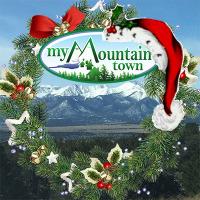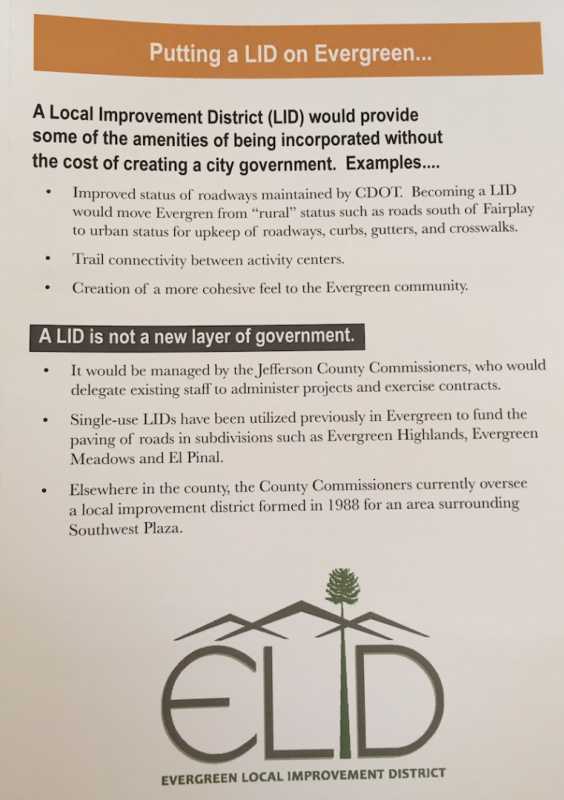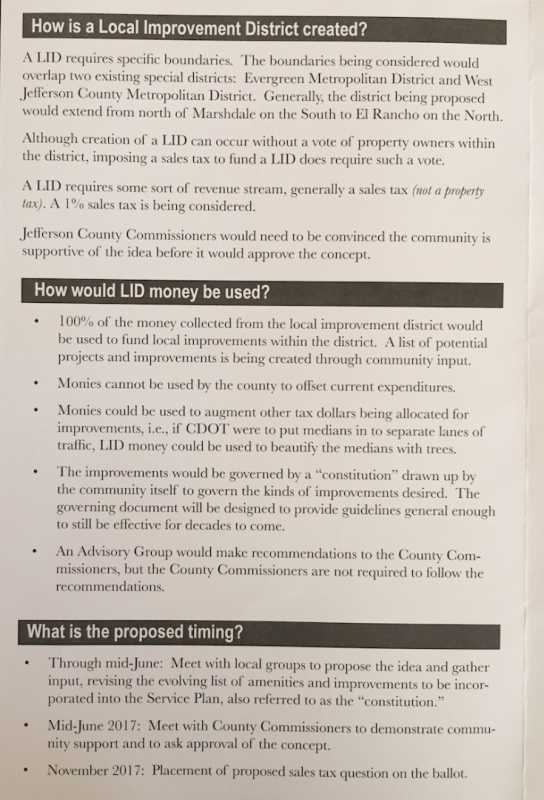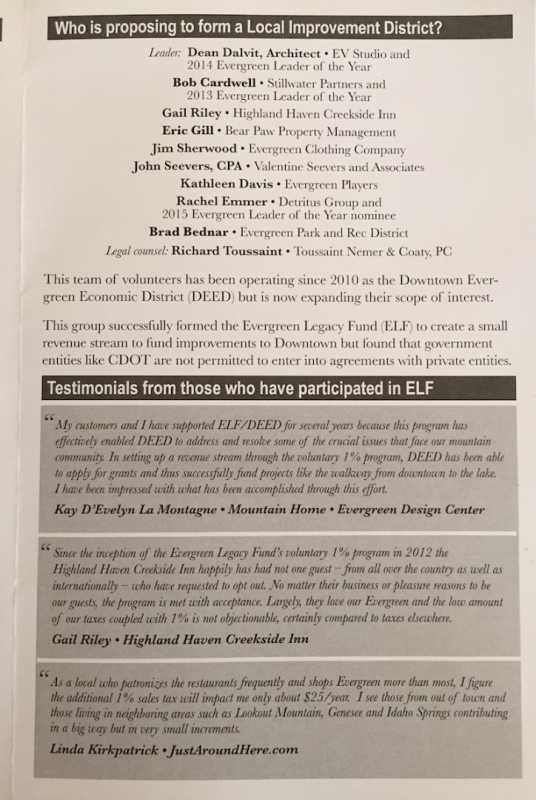- Posts: 2
- Thank you received: 0
- Forum
- The Highway
- The Campfire
- Evergreen Local Improvement District - Upcoming Community Town Hall Meeting
Evergreen Local Improvement District - Upcoming Community Town Hall Meeting
- EVStudio
-
 Topic Author
Topic Author
- Tourist
-

May 15, 2017
Join the Downtown Evergreen Economic District board for an information and input session on the possibility of creating a Local Improvement District for the greater Evergreen area. We’re calling it the Evergreen LID, or ELID for short!
When: Tuesday, June 6th, 2017
5:30 – 7pm
Where: Evergreen Lake House
RSVPs are not required, however it would be super helpful if you did!
RSVP HERE
DEED champions Local Improvement District for greater Evergreen area
May 13, 2017
Local Improvement District (LID) would provide some of the amenities of being incorporated without the cost of creating a city government. Examples….
• Improved status of roadways maintained by CDOT. Becoming a LID would move Evergreen from “rural” status such as roads south of Fairplay to urban status for upkeep of roadways, curbs, gutters, and crosswalks.
• Trail connectivity between activity centers.
• Creation of a more cohesive feel to the Evergreen community.
A LID is not a new layer of government.
• It would be managed by the Jefferson County Commissioners, who would delegate existing staff to administer projects and exercise contracts.
• Single-use LIDs have been utilized previously in Evergreen to fund the paving of roads in subdivisions such as Evergreen Highlands, Evergreen Meadows and El Pinal.
• Elsewhere in the county, the County Commissioners currently oversee a local improvement district formed in 1988 for an area surrounding Southwest Plaza.
How is a Local Improvement District created?
A LID requires specific boundaries. The boundaries being considered would overlap two existing special districts: Evergreen Metropolitan District and West Jefferson County Metropolitan District. Generally, the district being proposed would extend from north of Marshdale on the South to El Rancho on the North.
Although creation of a LID can occur without a vote of property owners within the district, imposing a sales tax to fund a LID does require such a vote.
A LID requires some sort of revenue stream, generally a sales tax (not a property tax). A 1% sales tax is being considered. Jefferson County Commissioners would need to be convinced the community is supportive of the idea before it would approve the concept.
How would LID money be used?
• 100% of the money collected from the local improvement district would be used to fund local improvements within the district. A list of potential projects and improvements is being created through community input.
• Monies cannot be used by the county to offset current expenditures.
• Monies could be used to augment other tax dollars being allocated for improvements, i.e., if CDOT were to put medians in to separate lanes of traffic, LID money could be used to beautify the medians with trees.
• The improvements would be governed by a “constitution” drawn up by the community itself to govern the kinds of improvements desired. The governing document will be designed to provide guidelines general enough to still be effective for decades to come.
• An Advisory Group would make recommendations to the County Commissioners, but the County Commissioners are not required to follow the recommendations.
What is the proposed timing?
• Through mid-June: Meet with local groups to propose the idea and gather input, revising the evolving list of amenities and improvements to be incorporated into the Service Plan, also referred to as the “constitution.”
• Mid-June 2017: Meet with County Commissioners to demonstrate community support and to ask approval of the concept.
• November 2017: Placement of proposed sales tax question on the ballot.
Please Log in or Create an account to join the conversation.
- Mountain-News-Events
-

- Mountain Legend
-

Area business owners proposing a local improvement district to fund road improvements
By Josie Klemaier | This email address is being protected from spambots. You need JavaScript enabled to view it. | YourHub
May 11, 2017 at 11:08 am
Read more here: www.denverpost.com/2017/05/11/evergreen-...putting-a-lid-on-it/Of all the assets the picturesque foothills community of Evergreen offers its residents, from numerous parks and trails to a historic downtown, it is missing a big one: local government.
A group of area business owners and leaders is floating an idea they say would help the community with the challenges related to relying on outside agencies to fix things like streets and sidewalks in a timely manner.
“In every way it’s like incorporating without all the different layers of bureaucracy and government that comes with,” said Dean Dalvit, a local architect with EV Studios and president of the Downtown Evergreen Economic District, or DEED.
Dalvit and others, including a representative of Evergreen Park and Recreation District, propose creating the Evergreen Local Improvement District, or LID, and a 1 percent sales tax.
My Mountain Town Community Calendar - filter events by Category, date, or keyword to easily find events of interest. Add your community, church, or non-profit event to the calendar yourself! Click here to access the submission form. Businesses: please contact us for more information on adding your events! Questions? Email
Community News, Events, and Calendar Forum - Check here for the latest happenings in our community and add your own!
Please Log in or Create an account to join the conversation.
- CanyonCourier
-

- Mountain Legend
-

- Posts: 717
- Thank you received: 10
Members of the public were invited to a DEED meeting Wednesday, April 19 to hear about DEED’s proposal to create the Evergreen Local Improvement District.
According to DEED President Dean Dalvit, of EV Studio, the district’s boundaries would be the present Evergreen and West Jeffco metro districts — extending as far north as El Rancho and as far south as Highway 73 and Skyline Drive.
Subscribe and read more here: www.canyoncourier.com/content/proposal-s...evergreen-become-lid
Proposal suggests Evergreen become LID
By Corinne Westeman
Wednesday, April 26, 2017 at 11:17 am
Canyon Courier is your source for local news, sports, events, and information in Evergreen, CO, and the surrounding area.
www.canyoncourier.com
Subscribe to help support your local news!
Please Log in or Create an account to join the conversation.
- CanyonCourier
-

- Mountain Legend
-

- Posts: 717
- Thank you received: 10
Dalvit said DEED first heard about LIDs from Rosier, who lives in the Southeast Jeffco Local Improvement District (SJLID), which encompasses the area around Southwest Plaza. The district is funded by a half-cent sales tax on every dollar, Rosier confirmed, which county documents show voters passed with 84 percent in favor and 15 percent opposed.
The SJLID was formed in 1988, Rosier continued, and it is one of only four in the state — all in the Denver metro area. The district’s creation was meant to be temporary, but Rosier said residents voted to continue it indefinitely.
Rosier said the whole discussion about LIDs in the mountain area started about a year-and-a-half ago, when the county and CDOT were investigating how best to do different road improvement projects, specifically on state highways.
The county has looked at creating a special district, or a public improvement district, which is voted into creation by residents, run by a board of directors, and can generate revenue by levying property taxes.
Subscribe and read more here: www.canyoncourier.com/content/rosier-ela...istrict-south-jeffco
Rosier elaborates on LID process, district in South Jeffco
By Corinne Westeman
Wednesday, May 10, 2017 at 11:09 am (Updated: May 10, 11:10 am)
Canyon Courier is your source for local news, sports, events, and information in Evergreen, CO, and the surrounding area.
www.canyoncourier.com
Subscribe to help support your local news!
Please Log in or Create an account to join the conversation.
- MyMountainTown
-

- Mountain Champion
-

Please Log in or Create an account to join the conversation.
- MyMountainTown
-

- Mountain Champion
-

Incorporation: Why Evergreen never became a city
Written by Linda Kirkpatrick on Sunday, June 14 2015.
There's a lot more in the article, please click the link above to read more.Historically:
A study performed in 1968 when the population was about 2,700 concluded that incorporation would be economically feasible, particularly with a 2 percent sales tax. However, no action was taken at that time.
A series of public meetings in the mid-seventies was held to formalize the investigation of local control options. In 1981 Dames & Moore was hired to conduct a study, which noted that, besides the mental and emotional stress on the community of going through the difficult process of incorporation, most people would be opposed if their taxes were noticeably increased.
This was a time of tremendous growth with about 10,000 new residents arriving in the seventies, setting a pace that would continue until the millennium.
The main reason to consider incorporation was to have greater control over the growth of the area.
In about 1993 the Evergreen Chamber of Commerce held a forum on the subject of incorporation. To summarize the thoughts of the Commissioners:
- If Evergreen incorporated, 95% of existing taxes paid to the county would continue; almost none would be diverted to a city government; expenses of a city would be covered by all new taxes
- Evergreen would likely need to contract with the county (and pay for) services such as road construction, maintenance, and snow plowing;
- They would love to see Evergreen incorporate because it would generate new money for them.
As noted, incorporating adds another layer of government and many of the services that residents currently receive due to the taxes they pay, such as Jeffco Road & Bridge plowing and Jeffco Sheriff's Office patrolling, would now need to be paid for separately and in addition to county taxes (plus "administration, human resources, budgeting, election costs, city attorney, clerk and recorder, IT, municipal court, public works, finance and planning, city manager and staff" according to Commissioner Donald Rosier in 2015).
In contrast, a Local Improvement District does not add another layer of government - it is administered by staff at Jeffco. The revenue collected within the LID cannot go for staff salaries, only for projects designed within the LID, and it cannot be diverted by government staff to any other projects, departments, or expenses.
There are two steps to this process of implementing the Evergreen LID (ELID): 1.) submitting a petition to the Jefferson County Commissioners for approval of the LID and its defined boundaries; 2.) a ballot measure for the residents within the LID to approve a 1% sales tax to be collected in perpetuity.
The petition does not require obtaining voter signatures, it is merely a legal document that the Committee must fill out and submit, which they expect to complete by the end of this summer or early fall. Once that is approved, a ballot measure will then be put before the voters either this November or May 2018 asking residents of the ELID to approve a 1% sales tax to be collected specifically and only for projects defined in the ELID. It is worth noting that this 1% sales tax increase will move Evergreen to a 5.5% sales tax total, which is still well below most other areas of Jefferson County, and will also replace the 1% sales tax that some businesses have already been voluntarily collecting for the Evergreen Legacy Fund. Those ELID projects will be decided by the residents of the Local Improvement District, which are now being solicited and collated by the ELID Committee, which was the reason they held the Town Hall Meeting Tuesday evening. The Evergreen Local Improvement District Committee will be requesting as part of the ELID that a Local Advisory Committee be required to meet annually with the County Commissioners to review and amend, as needed, the list of projects and their priorities.
If you have any questions or input to offer, please contact any of the members of the Evergreen LID Committee listed on the attachments in the previous post.
Please Log in or Create an account to join the conversation.
- CanyonCourier
-

- Mountain Legend
-

- Posts: 717
- Thank you received: 10
Over the past several weeks, DEED has been hosting meetings with local groups to discuss what a LID is, what it could do for Evergreen and other long-term impacts. Tuesday night's meeting at the Lake House was the first time DEED had hosted a town hall-style assembly on the topic.
Public reaction
Some Evergreen residents, such as Richard Blodgett and Brian Ehrle, said they were undecided on the issue. Blodgett said he was uncomfortable with the idea that the LID was proposed to last in perpetuity, and Ehrle commented that he wanted to see a study on how successful LIDs have been elsewhere in the state and in the country.
Others asked about whether the district would have the power to condemn property to use for other purposes.
Richard Toussaint, DEED's legal counsel, clarified that Jeffco would continue to have that power, but the LID itself would not. However, if written into the service plan, the district could have the power to purchase property.
Read more here: Town hall meeting on ELID proposal draws mixed responses
www.canyoncourier.com/content/town-hall-...raws-mixed-responses
By Corinne Westeman
Wednesday, June 7, 2017 at 12:35 pm (Updated: June 7, 1:28 pm)
Canyon Courier is your source for local news, sports, events, and information in Evergreen, CO, and the surrounding area.
www.canyoncourier.com
Subscribe to help support your local news!
Please Log in or Create an account to join the conversation.
- MyMountainTown
-

- Mountain Champion
-

Filed under: Uncategorized — Greater DEED @ 8:03 am
As we continue in our efforts to share information about the Evergreen LID with the community, we will be making some adjustments to our website while we build an entirely new site that will host Frequently Asked Questions, Videos and other great content. In the meantime, Evergreenlegacyfund.org, Evergreenlegacyfund.com and Evergreenlegacyfund.net will all redirect to this site: greaterdeed.wordpress.com.
We apologize for anyone being directed to the old WordPress site if you have an old link from a previous post or you had saved it in your “favorites” or “history” folders for quick access – it will say that the authors took the site down. We didn’t…we just changed the URL. Thanks for your patience while we get all the technical stuff worked out!
New url: greaterdeed.wordpress.com/
Please Log in or Create an account to join the conversation.
- MyMountainTown
-

- Mountain Champion
-

A BILL FOR AN ACT CONCERNING THE AUTHORITY OF A LOCAL IMPROVEMENT DISTRICT.
Colorado Revised Statutes Title 30 Government County § 30-20-603 Improvements and funding authorized--how instituted--conditions
DEPARTMENT OF REGULATORY AGENCIES Division of Securities REGULATIONS FOR THE MUNICIPAL BOND SUPERVISION ACT 3 CCR 7 04 - 2
What are the sales tax rates for Jefferson County?
Regarding the Evergreen Legacy Fund: Downtown Evergreen's 1% Solution
Greater Downtown Evergreen Economic District 2015 presentation
Please Log in or Create an account to join the conversation.
- Mountain-News-Events
-

- Mountain Legend
-

ELID Powerpoint Presentation Slides
Last update from ELID:
ELID Project Categories and Advisory Committee
June 25, 2017
In the first draft of the Petition, or “Constitution” which will guide the ELID, we have compiled over 160 written comments from the community along with countless additional feedback from local group presentations, emails and conversations that we’ve had over the past 3+ years since we started the Trails Master Plan process. The categories outlined in the Purposes for the ELID are as follows:
Transportation Infrastructure
This includes things like Safety improvements on our highways, Curb/Gutter and sidewalks in Activity Centers, On-Street parking improvements in Activity Centers, Improved pedestrian crossings on arterial roadways and Activity Centers, Drainage and erosion control within Activity Centers.
Trail Connectivity
This includes completing trail connections throughout the District so there is a unified and safe bike and pedestrian system throughout the District. Jefferson County’s Evergreen Trails Master Plan outlines a starting point to these types of projects.
Public Amenities
This includes all of the things one would expect to have available in any of the Activity Centers to provide convenience and safety to the public. Things such as public restrooms, wayfinding signage, waste and recycling receptacles, thoughtful and efficient lighting that improves safety while also preserving the dark night sky.
Natural Resources
Preservation of our Bear Creek watershed within the District as well as wildlife management measures for safer highways throughout District. Also, burying powerlines in Activity Centers and critical view corridors to return Evergreen back to it’s natural setting.
Art, Culture and Landscaping
Incorporating landscaping and public art along arterial roads and in Activity Centers to soften the impact of the existing corridors. Where new improvements are made, include Landscaping and public artwork to complement the natural setting of Evergreen. Example: Instead of a plain concrete wall at a bridge or underpass, considering a mural or landscaping to soften its visual impact.
Exclusions
(This is very important)
Any infrastructure improvements otherwise required by any agencies having jurisdiction as well as any maintenance operations otherwise required by those agencies.
And MOST IMPORTANTLY:
The ability for an ELID Advisory Committee to update the purposes and specific projects in accordance with community priorities through public process and input over time.
***This last point, written into the constitution, underscores that an ELID is not a list of specific outcomes, but rather, a boundary of land with a legal mechanism to accomplish specific outcomes as guided by the constitution and established by the Advisory Committee to address community priorities that can change over time. So if you don’t see something you feel strongly about in this general list, that’s ok because you will have a voice in the public process in ways you never had before. Similarly, if there is something in the general list you strongly oppose, that’s ok too for the very same reasons. The priorities of the community will be solicited publicly, reviewed annually and inform decision-making at the county level. Here’s how that works, based on the first draft language in the Constitution…
Advisory Committee:
The Advisory Committee would be appointed by the BOCC through a process where applicants would be interviewed and selected based on the following criteria: 1) Qualifications of applicant to serve, 2) Distributed representation across the entire District and 3) Distributed representation among residential property owners, commercial property owners and business owners within the district. The Advisory Committee shall have no fewer than five members and no more than seven members at any time and the positions shall not be term limited but should be re-assessed and re-appointed every two years. The Advisory Committee shall have a minimum of one public town hall style meeting each year, along with other methods to gather community input on community priorities, and meet with the BOCC no less than twice per year to share gathered information, advise on priorities for the community and consult with the BOCC or appointed staff on past, present and future projects.
greaterdeed.wordpress.com/
Our thanks to ELID for linking to the video we took.
My Mountain Town Community Calendar - filter events by Category, date, or keyword to easily find events of interest. Add your community, church, or non-profit event to the calendar yourself! Click here to access the submission form. Businesses: please contact us for more information on adding your events! Questions? Email
Community News, Events, and Calendar Forum - Check here for the latest happenings in our community and add your own!
Please Log in or Create an account to join the conversation.
- Forum
- The Highway
- The Campfire
- Evergreen Local Improvement District - Upcoming Community Town Hall Meeting











